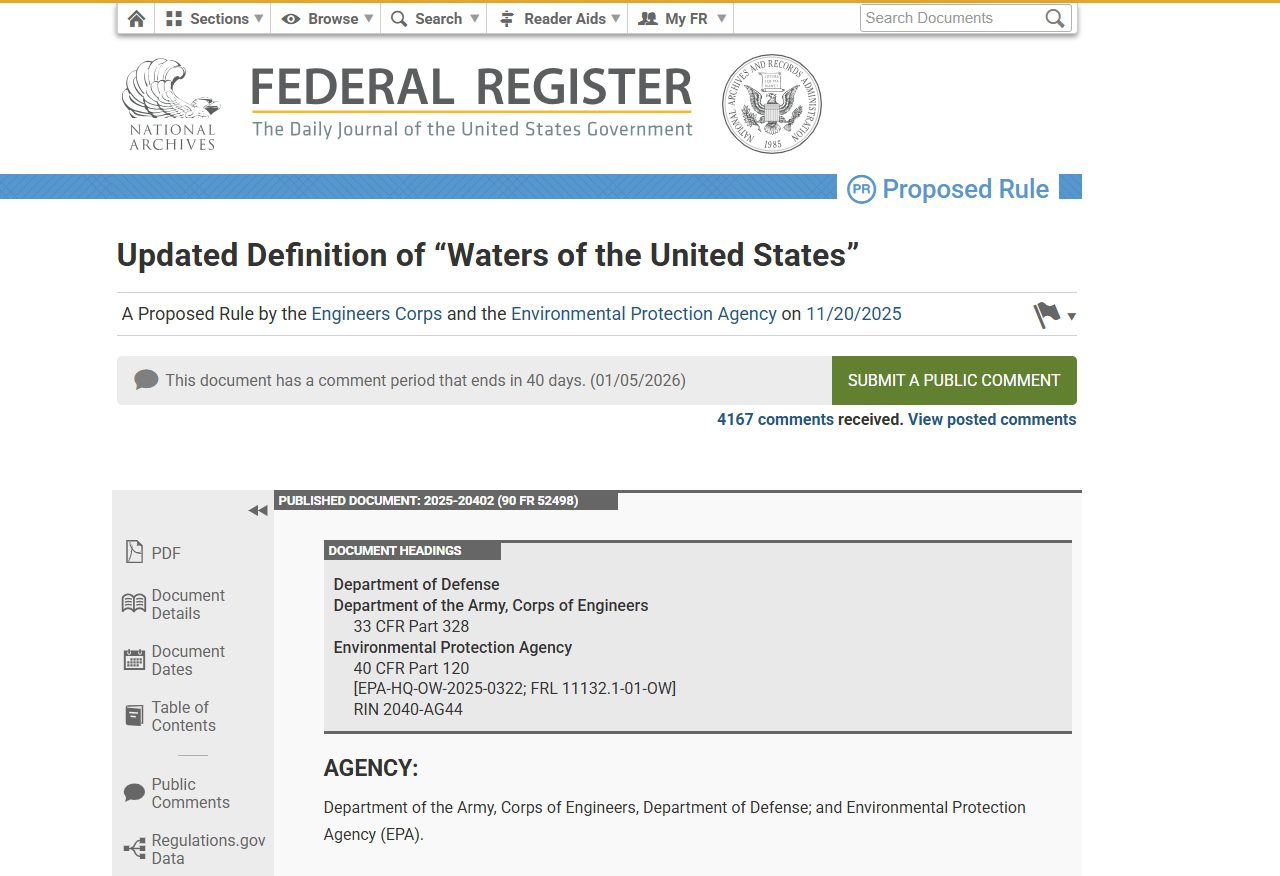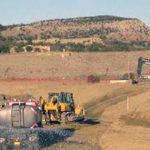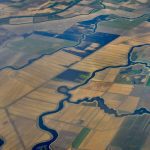- Federal agencies released a proposed update to the “waters of the United States” definition.
- The proposal responds directly to the United States Supreme Court’s 2023 Sackett decision.
- The rule would revise federal jurisdiction over streams, wetlands, lakes, and ditches.
- Public comments are due January 5, 2026.
- As of November 26, 2025, the docket lists 4,167 submitted comments.
Thursday, November 27, 2025 — The United States Environmental Protection Agency and the United States Army Corps of Engineers released a new proposed rule on November 20, 2025 revising the definition of “waters of the United States, ” also known as “WOTUS” The proposal is intended to align the Clean Water Act’s regulatory framework with the United States Supreme Court’s 2023 ruling in Sackett v. Environmental Protection Agency, which restricted federal authority over certain wetlands and smaller streams. According to the agencies, the proposed revisions are designed to improve consistency and provide clearer guidance for landowners, regulators, and Tribes.
” also known as “WOTUS” The proposal is intended to align the Clean Water Act’s regulatory framework with the United States Supreme Court’s 2023 ruling in Sackett v. Environmental Protection Agency, which restricted federal authority over certain wetlands and smaller streams. According to the agencies, the proposed revisions are designed to improve consistency and provide clearer guidance for landowners, regulators, and Tribes.
The Federal Register notice states that the proposal would modify jurisdictional categories in several parts of the existing rule. It would also update definitions the Court identified as inconsistent with the Clean Water Act, including the term “adjacent,” which now requires a “continuous surface connection” rather than relying on proximity alone. The agencies note that these changes are being proposed to respect the limits described in the Sackett ruling while maintaining the Clean Water Act’s objective to protect the quality of the nation’s waters.
notice states that the proposal would modify jurisdictional categories in several parts of the existing rule. It would also update definitions the Court identified as inconsistent with the Clean Water Act, including the term “adjacent,” which now requires a “continuous surface connection” rather than relying on proximity alone. The agencies note that these changes are being proposed to respect the limits described in the Sackett ruling while maintaining the Clean Water Act’s objective to protect the quality of the nation’s waters.
Key Areas Under Review.
Relatively Permanent Waters and Tributaries.
The proposal includes a detailed definition of “relatively permanent” waters, a category used to identify jurisdictional streams and other features with consistent flow. It also outlines updates to the definition of a tributary and describes how those updates would be implemented in field decisions across the country.
Adjacent Wetlands.
The agencies propose a revised definition of “continuous surface connection” to determine when adjacent wetlands fall under federal authority. This language reflects the United States Supreme Court’s requirement that wetlands must be directly connected at the surface to a jurisdictional water in order to be federally regulated.
Lakes, Ponds, and Interstate Waters.
The rule would remove “interstate wetlands” as a stand-alone category of jurisdiction, consistent with the Court’s interpretation of the Clean Water Act. The proposal would also adjust how lakes and ponds are evaluated, including the removal of the term “intrastate” in one section of the rule to avoid confusion identified during earlier implementation.
Exclusions and Implementation.
The proposed rule would revise several exclusions, including the treatment of waste-treatment systems, prior converted cropland, ditches, and groundwater. Implementation guidance for each exclusion is included in the notice, reflecting feedback gathered during earlier public outreach efforts.
Public Meetings and Opportunities for Input.
The Environmental Protection Agency and the Army will hold two public meetings with both in-person and virtual participation. Individuals wishing to speak must register in advance, and each commenter will have three minutes to provide oral remarks. The agencies state that written comments will receive the same consideration as oral comments submitted at the meetings.
Members of the public may submit written comments until January 5, 2026. As of November 26, 2025, the docket already includes 4,167 comments, reflecting high national interest in the proposed changes.
until January 5, 2026. As of November 26, 2025, the docket already includes 4,167 comments, reflecting high national interest in the proposed changes.
Implications for the West.
While the proposed rule applies nationwide, its effects will be significant throughout the arid West, where hydrology, landownership, and water rights are uniquely complex. The updated definitions would influence permitting decisions for projects involving wetlands, ephemeral streams, agricultural ditches, and floodplain features. The Environmental Protection Agency notes that the proposal is intended to increase consistency and predictability for those working within the boundaries set by the Sackett ruling.
The agencies also emphasize that this proposal does not expand beyond the limits identified by the Court. Instead, it revises the rule to ensure that it operates within those limits while preserving federal enforcement authority where appropriate.
Next Steps.
The agencies will review public comments after the comment period closes on January 5, 2026. After reviewing the input, they may finalize, modify, or withdraw the rule. Comments submitted during the public meetings or through written submissions will be treated equally.
Frequently Asked Questions
What is “waters of the United States”?
It is a legal term used in the Clean Water Act to identify which rivers, streams, wetlands, and other water features fall under federal jurisdiction for pollution control and permitting.
Why is the definition being updated again?
The United States Supreme Court’s 2023 Sackett decision required significant changes to federal interpretation of wetlands and smaller streams. This proposal is intended to reflect the Court’s ruling and provide clearer guidance to agencies and the public.
Does the proposed rule expand federal authority?
The Environmental Protection Agency states that the proposal is written to remain within the limits described by the Supreme Court. It revises earlier regulatory language but does not seek to extend authority beyond those limits.
How can the public participate?
People may submit written comments or speak at one of the scheduled public meetings. All comments must be received by January 5, 2026.
How many comments have been submitted so far?
As of November 26, 2025, the docket contains 4,167 comments.
When will the rule be finalized?
No specific date is provided. The agencies will review comments and determine next steps after the close of the public comment period.





